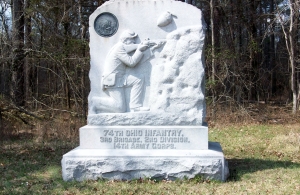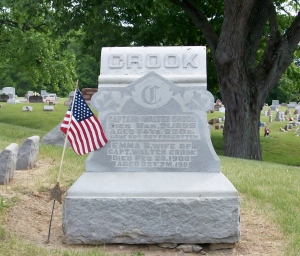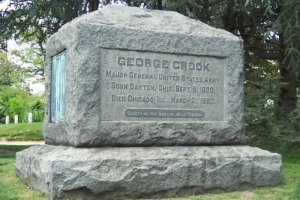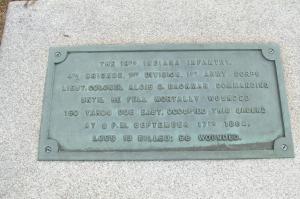Killed at Chickamauga
There a no words that can describe the horror or cost of the battle of Chickamauga, than those written by one who experienced the horror of battle there.
There a no words that can describe the horror or cost of the battle of Chickamauga, than those written by one who experienced the horror of battle there.
Another good post from my friend and master blogger, Craig Swain. Take special note of the link the Lee Whites blog about the breastworks on the Chickamauga battlefield. And for this desiring a very good read on the battle, check out the link to Lee’s new book “Bushwacking On A Grand Scale.”
 Monument of the 74th OVI, Chickamauga National Battlefield.
Monument of the 74th OVI, Chickamauga National Battlefield.Over the next couple of days, I will be posting a series of short articles on the men and units of the Buckeye State who fought in the Battle of Chickamauga. Below is the first article in this series.
While the exploits of Brigadier General George Crook during the American Civil War and the Indian Wars that followed are well documented, what is little-known is that George’s older brother, Walter, raised and served as the Captain of Company F, 74th Ohio Volunteer Infantry. Company F’s roster included many men from the Vandalia and Butler Township, Ohio, area where I currently reside.
Captain Crook, who was severely wounded in the thigh at Stones River, commanded Co. F throughout the entire war. In my view, Captain Crook (as he liked to be called) was a perfect example of the company grade officers of the war, who, after leading their neighbor “citizen soldiers” through many difficult marches and battles, returned home and help rebuild a country torn apart by four years of civil war.
The battlefield of Chickamauga was the only one shared by the brothers during the conflict. George was in command of the Second Division of the Army of the Cumberland’s Cavalry Corps, while Walter was leading his beloved Company F of the 74th Ohio which was serving in the 3rd Brigade, 2nd Division, XIV Corps, also with the Army of the Cumberland. Even though their units were separated by less than a mile during the night of September 19th, it is highly doubtful they had the opportunity to meet, even for a few hurried words over a cup of coffee and a piece of hardtack.
Both brothers survived the battle and the war, with George gaining even more fame after the war as arguably the best Indian fighter in the army. Though five years younger than Walter, he died eight years earlier in 1890 of a sudden heart attack. Today he rests at Arlington Cemetery under an imposing granite monument inscribed with not only his military commands and accomplishments, but also an engraving of his meeting with the great Apache war chief Geronimo, who greatly respected the man the Apache had dubbed “Nantan Lupan,” or “Grey Wolf.”
As for Walter, after mustering out in 1865, he returned home to Butler Township, Ohio, and became a rather prominent businessman in his community. He worked as both the freight agent and postmaster of the small crossroads hamlet of Tadmor, and served a term in the Ohio Senate. Never forgetting his men of Co. F, Walter was a founding member of the Milton Weaver GAR Post 594 in Vandalia (named after a young soldier of Company F who fell at the battle of Jonesboro, Georgia). Walter passed away in1898, and he lies buried in Maple Hill Cemetery in Tipp City, Ohio, near many of his fellow “Boys of 61” who followed him to war all those many years before. His headstone inscription is a simple one, with the usual information of age and date of death, along with a simple motto of “Gone, But Not Forgotten.” But, before his name, the headstone is inscribed with the one word that perfectly defined this man, and speaks volumes of the importance of that period of his life when Walter led the men and boys of Company F, on the march, in camp, and through the horrific crucible of battle.
That word is Captain.
 Gravestone of Captain Walter Crook, Co. F 74th OVI. Maple Hill Cemetery. Tipp City, Ohio
Gravestone of Captain Walter Crook, Co. F 74th OVI. Maple Hill Cemetery. Tipp City, Ohio Gravestone of Major General George Crook, Arlington National Cemetery.
Gravestone of Major General George Crook, Arlington National Cemetery.The New Animated Map from the Civil War Trust
Just in time for the 150th anniversary of the Battle of Chickamauga.
Lt. Colonel Alois O. Bachman was killed while leading the “Black Hats” of of the 19th Regiment, Indiana Volunteer Infantry on the morning of September 17, 1862. This is the story of his first day of regimental command and, tragically, the last day of his life.
A native of Madison Indiana, Bachman had previously served as a Captain in the 6th Indiana Volunteer Infantry (90 Days). He was commissioned Major of the 19th in late July 1861, receiving his promotion to Lt. Colonel of the regiment the following February. Due to injuries suffered at the Battle of Brawner Farm, and the physical and emotional toll of the campaign since that time, the Colonel of the 19th, Solomon Meredith, was unable to take the field; consequently, the 23-year-old Bachman became the commander of the regiment soon after the September 14th fight for Turners Gap.
Advancing with the other black-hatted “western” regiments of Brigadier General John Gibbon’s brigade, the 19th advanced through Farmer Miller’s soon-to-be infamous cornfield. Gibbon, in an attempt to stop the harassing fire of confederate troops on the right of the brigade ordered the 19th, along with the 7th Wisconsin, to cross the Hagerstown Pike. Moving rapidly by the flank to their right, the two black-hatted regiments crossed the pike and quickly cleared the rebel skirmishers out of the area finding, much as the enemy had, that the sloping ground provided excellent cover for them to pour a horrific flanking fire into exposed left and rear of both Starkes and Colonel James Jacksons Confederate brigades, who in turn were firing on the 6th Wisconsin’s position in the cornfield to the east of the pike.
Ordering his regiment to change front from column to the left, and holding his hat in one hand and his sword in the other, Alois shouted, “Boys, the command is no longer forward, but now it is follow me!” as he led his “Swamp Hogs” up over the protective cover of a rock ledge and charged east across the Hagerstown Pike. Here they pitched into the unsuspecting troops of Hampton’s Legion, who had left their left flank dangling “in the air” while intently advancing on the exposed position of Battery B of the 4th U.S. Artillery. The fierce attack of the 19th spoiled the rebel attempt to capture Battery B; however, the sheer momentum of their advance carried the regiment to the crest of a small rise 150 yards east of the pike. Here, in a very exposed position, the Hoosiers were met by a withering fire of southern musketry. It was at this point in the contest that Lt. Colonel Bachman received his fatal wound. Immediately taking command of the regiment, 19-year-old Captain William Dudley rallied the 19th, and under severe fire from the northern edge of the West Woods was able to safely extradite them from their position on the hill. The regiment fell back west over the Hagerstown Pike and then north out of the fight.
Below you will find young Captain Dudley’s official report of the fight, which gives one some idea of the great intensity of both the advance and the short, but fierce, struggle east of the pike. Remember this report was written by a lad of 19 years.
CAMP, GIBBON’S BRIGADE,
September 21, 1862.
Lieutenant FRANK A. HASKELL,
Acting Assistant Adjutant-General, Gibbon’s Brigade.
DEAR SIR:
I have the honor to submit the following report of the part taken by the Nineteenth Indiana Volunteers in the battle of the 17th instant:
Owing to the fall which Colonel Meredith received in the battle of the 28th of August, and the subsequent fatigue and exposure of the marches up to the 16th instant, he was unable to take command on our movement across the Antietam Creek. The command now fell upon Lieutenant-Colonel Bachman. Immediately on crossing the cheek we were advanced in line of battle up the hill in a plowed field which covered the brow of the hill. Lieutenant Colonel Bachman immediately deployed Company A, Sergeant Eager, forward as skirmishers through the corn-field, in order to protect our front and the crossing of our division, which, being accomplished, we were ordered to join the brigade and move farther up to the right. We stopped for the night, having closed column by division on first division, right in front.
Early on the morning of the 17th instant we were called up and prepared to go into action. We moved directly to the front, in column by division. Our first casualty occurred in a peach orchard near the destined battle-field.
We now moved to the edge of a corn-field near a stone house, which was immediately used as a hospital. Here we lay down, while our skirmishers were scouring the corn-field in front. We were soon ordered to the right, to a piece of woods which skirted the battle-field on the right. Here we deployed column and formed our line of battle on the right of the Seventh Wisconsin Volunteers, and Lieutenant-Colonel Bachman ordered Company B, then my command, to deploy forward as skirmishers. This being done, the regiment moved slowly forward till the right was through the wood, when we halted. It was at this time that the attempt was made to take Battery B, Fourth Artillery, which was stationed at the straw stacks near the stone house hospital. Upon seeing the advance of the enemy, Lieutenant-Colonel Bachman at once called in the skirmishers, and changed front forward on the tenth company, so as to front the left flank of the enemy.
As soon as it was practicable we opened fire on them, and we have every reason to believe that our fire was very effective in repulsing their attack on the battery. Soon we saw the enemy falling back in great disorder, and it was at this juncture that the gallant Lieutenant-Colonel Bachman, yielding to the urgent appeals of the men, gave the order to charge, and, hat in hand and sword drawn, he gave the order “double-quick”, and bravely led on, the men following, cheering as they advanced. We charged across the pike and followed the retreating rebels to the brow of the hill, over which they had a strong reserve of infantry and three pieces of artillery, which pieces seemed to have been abandoned by horses and men. It was at this point that brave Lieutenant-Colonel Bachman fell, mortally wounded, and I took command immediately. As soon as we could carry his body to the rear, we fell back to the pike and rallied. Here we received an enfilading fire, the enemy having succeeded in approaching within 100 yards of our right, under cover of the woods. We again fell back to our old position, and remained there until relieved by one of General Patrick’s regiments. We then fell back in good order slowly about 30 rods into the open field.
In making the charge and retiring, our colors fell three times, the bearers severely wounded. When they fell the last time, they were picked up and carried off the field by Lieutenant D. S. Holloway, of Company D. One of our men captured a rebel flag and took it to the rear. In this charge Lieutenant William Orr, Company K, was severely wounded. At this time, about 2 o’clock p. m., we retired from the field in good order, and formed in a strip of woods to the rear of the battle-field with the other three regiments of our brigade, for the purpose of stopping stragglers.
Our loss was, killed, Lieutenant Colonel A. O. Bachman and 7 men; wounded, Lieutenant William Orr, Company K, and 70 men; missing, 26 men.
The officers all vied with each other in the performance of their duty, and too much praise cannot be awarded to the non-commissioned officers for their gallant conduct; and the men of this regiment are all brave men, if we except the few who found their way to the rear when danger approached.
I am, very respectfully, your obedient servant,
WILLIAM W. DUDLEY,
Captain Company B, Commanding Nineteenth Indiana Volunteers.

Marker describing the action of the regiment and the approximate location where LTC Bachman received his mortal wound.
After the battle, Alois’ remains were returned home to Madison, Indiana, for burial in Springdale Cemetery. As reported below in the September 27th edition of the Madison Courier, his funeral procession was, to that date, the largest ever held in the town:
Madison Courier, September 27, 1862
The funeral of the late Lieut. Col. A.O. Bachman yesterday afternoon was more largely attended than anyone ever before held in this city. The cortege was almost entirely of a military character. Six companies of the guard force of this city, the 93rd Infantry, and two companies of the 4th Cavalry were in the procession, commanded respectively by Col. Saring of the Legion, and Col. Grey, of the 4th Cavalry. The music was furnished by the Madison Brass Band. The procession was of course very extended, and some difficulty was experienced in drawing the column up before the grave. The salutes fired by three companies of the 100th regiment. A large crowd had assembled in the Cemetery to witness the ceremonies, and when the body was lowered into the grave, and the solemn music of the band was wailing over the dead, a scene of solemnity was presented that is seldom witnessed, and over the grave of one whose gallantry, merit, early death, and bright hopes for the future have never been excelled.
Sources:
OFFICIAL RECORDS: Series 1, Vol 19, Part 1 (Antietam – Serial 27) , Pages 251 – 252
The Iron Brigade in Civil War and Memory, by Lance Herdegen, Savas Beatie, 2012.
“I Dread the Thought of the Place.” by Scott D. Hartwig. Giants in Their Tall Black Hats – Essays on the Iron Brigade. Ed. Alan T. Nolan and Sharon Eggleston Vipond. Bloomington: Indiana University Press, 1998.
MadisonCourier.Com, September 29th, 2012 edition.
One hundred fifty-one years ago today, Lt. Colonel Augustus H. Coleman was killed in action leading his men of the 11th Ohio Volunteer Infantry in one of the early assaults on the lower, or Rohrbach, bridge during the battle of Antietam. Born in 1829, Augustus was raised in Troy, Ohio, where his father was a very prominent businessman and active in local politics. At the outbreak of the war, Augustus was 31 years old, residing near Troy with his wife Clara and their two small children, Rachael Augustus and George Edwin. Although Augustus had been appointed to the U.S.M.A. at West Point in 1847, it appears that he had some sort of difficulty with the curriculum and by 1851 had returned to the Troy area to engage in “agricultural pursuits.”
After the surrender of Fort Sumter and upon Presidents Lincoln’s call for 75,000 volunteers, men with the type of military training or background that Augustus had received at West Point were very much in demand. Within 48 hours of the President’s call, he had raised a company of 100 men which, with Augustus as its captain, was soon mustered in as Company D, 11th Ohio Volunteer Infantry, or Militia, for three months service. Later in 1861, the 11th was mustered into U.S. service for a term of three years, with Augustus being named Major of the regiment. By the spring of 1862 he had received a promotion to Lt. Colonel of the 11th.
As part of the famed “Kanawha” Division of the 9th Army Corps, Augustus was conspicuous in leading a bayonet charge to help recover two captured artillery pieces and secure the Federal occupation of Frederick, Maryland, on September 12th. Two days later, he was guiding his men through difficult, mountainous terrain in the tough fight for Fox’s Gap, where, according the regiment’s official report, he “took down the enemy’s colors with his own hands.”
September 17, 1862, found the 11th, along with the 28th and 36th O.V.I. regiments under the command of Brigadier General (and native of Montgomery County, Ohio) George Crook, positioned behind a low hill just to the east of the Rohrbach bridge. Given vague orders to charge over the rise and seize the stone bridge, the “Buckeyes” of the 11th crested the hill and were immediately met with a virtual hail of small arms and artillery fire from the rebel units posted on the west side of Antietam Creek. It was during this advance that Lt. Colonel Coleman (who had dismounted from his horse “Old Bull” just prior to the attack) was shot by a rebel “sharpshooter” and fell with a severe wound to his the right arm, dying within the hour. Without the presence of their commander, the 11th, now under the command of Major Lyman Jackson and under the continued small arms fire from the confederates entrenched across Antietam Creek, fell back to their starting point where they kept up harassing fire against the confederate positions on the west bank of the creek. Later in the day, they joined with several of the other units of the “Kanwaha” Division in advancing across the recently secured bridge to take up a position near the Otto Farm. Forced back by the timely attack of A. P. Hill’s Light Division on the Union left flank, the 11th took cover under the same bluffs that had provided such an impregnable position for the confederate infantry earlier in the day. For the boys from southwestern Ohio, the bloodiest day in American history was finally over. Losses for the 11th that day totaled 4 killed in action, 12 wounded, and 5 missing for a total of 21. Three days later, Major Jackson, in writing his official report of the action on the 17th, described with much emotion the fall of his friend and commander in the following manner:
Lt-Col. Coleman, moving with the left under a severe fire, was shot through the right arm by a sharpshooter, and died in about an hour after. I must say of this that no better, braver, truer officer ever served our country, and no regiment can feel a loss more sorely.”
Augustus’ body was returned to Troy, Ohio, and following a imposing funeral procession he was buried in Rose Hill Cemetery where under a much faded marble stone in the family plot he lies today. In the center of the Coleman plot is a large family monument where weathered words etched in marble relate the story of Augustus’ bravery and of his ultimate sacrifice in the defense of his country. Ironically his commission as Colonel, U.S. Volunteers to command his beloved 11th O.V.I. was dated September 17, 1862.
During my visits to Augustus’s grave I have often wondered if, while mourning her son’s gallant and tragic death, the thoughts of his mother Mary, ever turned from her sorrow, back to her childhood and the place of her birth, a place on the banks of a winding tranquil stream in Maryland, near a small, insignificant village named…Sharpsburg.
This tremendous print by Don Troiani will soon be released by Historical Art Prints
http://www.historicalartprints.com/
I was honored to be able to help on the research for this print with Don Troiani and Lance Herdegen to bring the above scene of gallantry and courage to life. Look for a future post on this blog on how that process worked and the very interesting story of Sgt. Major Asa Blanchard.
Today is the 185th Birthday of Major General George Crook. A son of the great state of OHIO, Crook was born on this day in 1828, near the small Miami-Erie canal town of Taylorsville, Ohio. A 1852 graduate of West Point, General Crook was a renowned officer in the Civil War, at different times commanding infantry and cavalry divisions in both the eastern and western theaters of the war. But his greatest fame came as perhaps the greatest and most respected Indian fighter in the Indian Wars. Fresh out of West Point, George was assigned to the 4th U.S. Infantry which was stationed in the Pacific Northwest, spending the the next 8 years in action against the Indian tribes of that region. After the America Civil War, he fought against the tribes of the American West, with his greatest fame coming with his successful campaigns against the Apaches, who came to hold him in such high regard they nicknamed him “Nantan Lupan” which means “Grey Wolf”
Other than those interested in U.S. military history during the last half of the 19th century, Crook is largely forgotten today. The site of his birthplace near modern day Huber Heights, Ohio is unmarked by any sort of historical marker, a situation that I hope to be able to rectify in the near future.
A very moving post from the “Irish in the American Civil War” blog
‘After I Am Dead, Write to My Wife’: An Irish Soldier’s Last Moments Revealed.
The Civil War Along the Potomac
Mike Cunningham
Civil War Photography
Events 2014 - 2019
Just another WordPress.com weblog
To explore the battles of Fredericksburg from the standpoint of the participants and the terrain they acted upon.
In Their Own Words- The Soldiers and Civilians of the Maryland Campaign
... a flanking fire of words!
(re)Living History, with occasional attempts at humor and the rare pot-luck subject. Sorry, it's BYOB. All I have is Hamm's.
June 27, 1864
Reflections of a High School History Teacher and Civil War Historian
Firearms, long range target shooting and associated history
Blogging since 2006. Now using ChatGPT technology to breathe new life into the story.
the conflict in the East
Campaigns of the U. S. Civil War
Chickamauga, the Civil War, and sometimes, just life